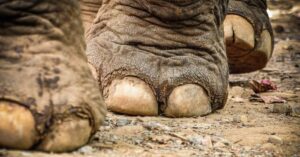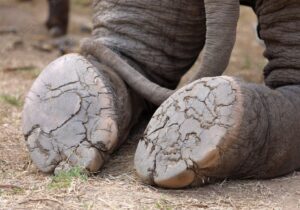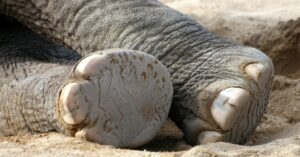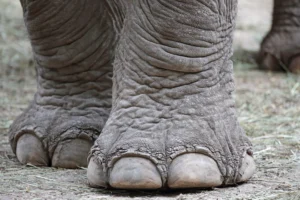Elephant feet are a marvel of evolutionary engineering, perfectly suited to support their massive size. Each foot has five toes and anywhere from three to five toenails, depending on the elephant species and whether it is a front foot or back foot. Their feet are cushioned with thick, leathery soles, which provide a sturdy base. Within these tough outer pads lies a spongy network of adipose tissue—aka fat—that functions like a shock absorber, helping to cushion their immense weight—up to 15,000 pounds in some cases! Despite their size, elephants are surprisingly stealthy on their feet and are able to move quietly across varied terrain like a clan of giant grey ninjas in search of bananas and sugar cane.
In terms of physiology, the elephant’s foot is a complex system designed for weight distribution. The toes are encased in thick, keratinous toenails, while the bottom of their foot is covered by a tough, rubbery pad, full of crevices. This pad helps distribute their weight evenly, preventing them from sinking too deeply into soft ground and making it easier to move across a variety of landscapes—from dusty plains to swampy wetlands. If you’ve ever wondered why elephants are so good at walking in deep mud without getting stuck, it’s because of these highly evolved feet, which can essentially “float” on soft ground, preventing them from becoming bogged down.


Foot care is an often-overlooked aspect of elephant health. In the wild, elephants roam long distances, which naturally keeps their feet in good condition. However, when living in captivity, things are a bit more complicated, and zookeepers and veterinarians need to closely monitor their feet. Routine foot care includes trimming the toenails and footpads as well as checking for abnormalities like cracks and infections, which can develop from a lack of movement, improper foot care, or even too much standing on hard surfaces, such as cement. In many cases, elephants need regular “mani-pedis” to maintain the health of their feet—because, unlike us, they can’t just stop by the nail salon for a pampering sesh!


Unfortunately, foot disease is one of the leading health issues in captive elephants, often caused by obesity, traumatic injuries, or lack of exercise. Over time, if not treated, these conditions can lead to severe pain or even permanent lameness, making it difficult for the elephant to walk. Foot abscesses, arthritis, and toenail infections from prolonged standing in wet conditions are just a few of the common foot conditions elephant develop in captivity. So, while elephants may be built to carry the weight of the world, a little TLC goes a long way to ensure their feet stay clean and healthy!
